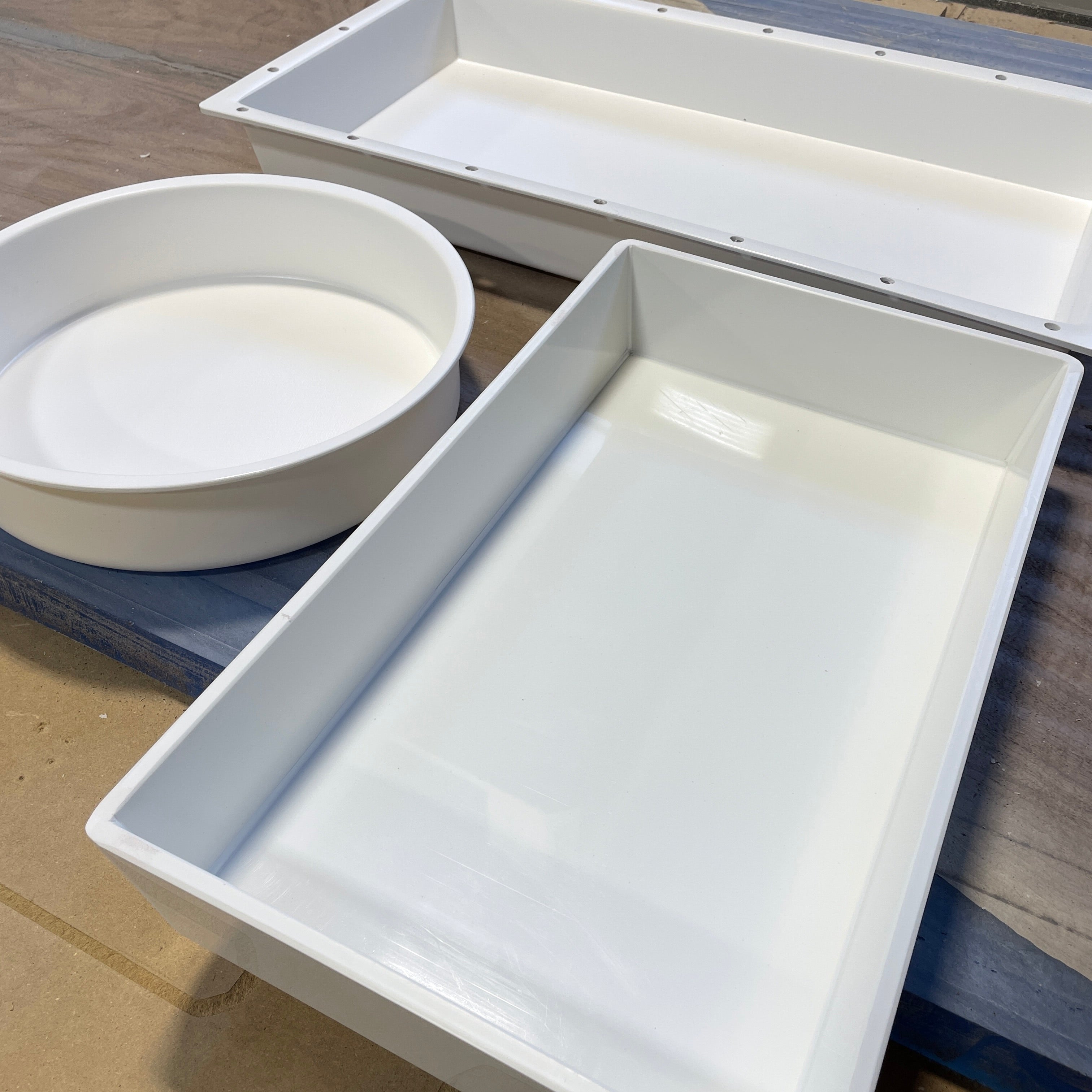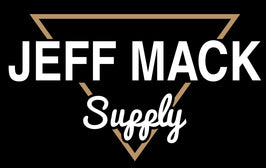What HDPE Mold Should I Buy?
What we Discuss:
Below we discuss Pro's + Con's of each style of HDPE forms and what kind of shop set up they can be best utilized in

Finding the Right Form: Balancing Needs and Efficiency in the Market
HDPE Resin molds are a popular choice in the woodworking industry due to their durability and ability to withstand high temperatures caused by the exothermic reaction that occurs when resin and hardener cure. The material is also lightweight and flexible so it's easy for you to remove your cured project from the form.
In reality, the 'perfect form' that caters to all your needs does not exist.
Every design comes with its own set of advantages and disadvantages, and the key lies in selecting the one that aligns best with your requirements and the tools at your disposal.
Nonetheless, it's undeniable that acquiring a pre-made form saves you valuable time and money compared to constructing a new form for each project you undertake.
Building your own form
When considering the pros of a custom-built form, one notable advantage is the ability to tailor it precisely to the size of your project, minimizing waste around the edges.
However, it is important to weigh the cons as well. There is a limited lifespan for multiple uses of the Tuck Tape used in their construction which wears out over time. Additionally, assembling such forms can be time-consuming, requiring a significant investment of your time.
Another risk to be aware of is the potential for resin leakage from the seams if they are not properly sealed with silicone. These considerations highlight the importance of carefully evaluating the trade-offs before deciding on a custom-built form for your specific needs.
Types of Shop that this Technique is best used for:
- Makers that build a lot of custom and unique sizes of wood+epoxy projects
- Makers that have a surplus amount of time to build out a form for their project
To watch a full tutorial on how to make your own form Click Here
One Piece Empire Molds (White Edition)
When it comes to utilizing the one-piece Empire Molds, there are several advantages to consider.
First, these molds offer great malleability, making it easier to extract your piece with a soft mallet. Another notable benefit is their reusability, allowing you to use them over 15 times, which proves to be cost-effective in the long run. These molds even comes equipped with hold-down bars, ensuring that your wood remains securely in place and prevents floating when resin is poured. Since these molds are manufactured out of one piece of HDPE there are NO seams that will crack when hitting a soft mallet repeatedly against the sides when you are taking your project out of the form.
However, it's important to be aware of potential challenges. In the case of the larger scale molds, they may not naturally sit perfectly flat on their own, which can impact the final outcome. Thankfully, a simple solution exists: employing larger clamps to bring the mold flat, enabling you to achieve the desired levelness. By utilizing this solution, you can effectively address this drawback and ensure that your larger one-piece empire molds sit securely and level, resulting in optimal outcomes for your projects. Another solution is to put the mold out in the sun to allow the heat to make the plastic-like material more flexible and able to sit flat.
Types of Shop that this Technique is best used for:
- Makers that have a high project turn over rate
- Makers that have set sizes of projects that they typically stick to

If your No Seal form develops a crack consider using Silicone to seal the area and pro-long the life of the form.
No Seal Forms
Designed with welded edges, these forms offer distinct advantages, as well as a few considerations.
Pro's:
- Sits flat on your table since the form is made up of 5 separate pieces that are all welded together at the seams. This eliminates the need for additional sealing, saving both time and effort.
- Can be used multiple times
- Versatility: No Seal forms come in various shapes and sizes, allowing for creativity and flexibility in resin projects.
Con's:
- Welded walls can crack over time
- Clamps are needed as well as HDPE Blocks so that your wood does not float and your clamps don't get submerged in resin.
- An additional step of release agent, such as mold release spray is best used in these forms to ensure easy removal from the form. This additional step can be necessary, depending on the complexity of the project and the resin used.
Silicone Forms
Silicone forms have become increasingly popular in the world of epoxy and resin DIY projects due to their user-friendly nature and versatility of shapes that they come in.
With proper care, these molds can withstand multiple casting cycles, making them a cost-effective choice for DIY enthusiasts who engage in numerous resin projects. Additionally, the non-stick surface of silicone molds eliminates the need for additional release agents. This not only saves time but also ensures hassle-free de-molding, resulting in smooth products that require less sanding.
Another significant benefit of silicone molds is their heat resistance, making them suitable for a wide range of applications, including casting with heat-sensitive resins. It should be noted if you are using a cheaper brand of resin to take your project out with care or slightly heat up the sides (hitting the edges with a quick pass of the heat gun) to avoid any tearing of the silicone.
There are lots of different kinds on the market, so make sure you get one that has thick walls which will guarantee multi-use out of one mold. When the silicone has thin walls, you will run the risk of the material breaking apart when taking your project out of the form. It is also important to consider a few other drawbacks associated with silicone forms.
While generally durable, they can be susceptible to tearing or deformation, especially with rough handling or prolonged use. Care must be taken to prevent damage and maintain the integrity of the molds. Additionally, silicone forms may have limitations when it comes to achieving rigid shapes and straight edges. This can restrict certain design possibilities for projects that require sharp angles or well-defined boundaries.
Types of Shop that this Technique is best used for:
- Makers who have limited access to tools and require a specific design or shape of Charcuterie Board
- Makers who are making a lower turnover of projects (Forms typically get 5+ uses out of them)
- Makers who are using cheaper brands of resin
One Piece Empire Molds (Black Edition)
These thin walled one piece forms are perfect for serving boards and art projects. They have even been tested and have been known to work with concrete projects having them easily pop out of the form.
The manufacturing process is the same as the White Series however the only notable difference is that they are made out of a thinner material making them even more malleable. It is good practice to have some clamps on hand to make sure the form sits flat on your work table.
Since these forms are so flexible, it makes it easy to extract your piece without any difficulties or even tools! Another notable benefit is their reusability, allowing you to use them over 10 times, which proves to be cost-effective in the long run.
Some things to consider when using these forms is to make sure you clean them with a damp cloth to get any cured resin residue out of the form before your next project. Since they are made from one piece of HDPE and formed to shape, after use they may begin to twist which can easily be fixed by placing the mold out in the sun for it to heat up the plastic-like material and allow it to sit flatter on your work surface. With the thinner material we recommend to use a higher quality resin to ensure nothing is sticking to the sides of your form restricting you to get the project out. You also want to make sure you are mixing the proper ratio making sure Part A and Part B have combine so that it doesn't give you any issues of sticking to the side of your form.
Types of Shop that this Technique is best used for:
- Makers that have a high project turn over rate
- Makers that have set sizes of projects that they typically stick to
- Makers that have clamps to pull the form down flat to their work surface
- Makers that use higher quality resins
What Tools and Accessories do I need with my form?
Whether you are making your mold from scratch or purchasing one online, you want to think ahead to properly prepare for your project. These Clamping blocks and dividers are of great use for making a larger form custom fit to a smaller project.
Having additional Clamps to make your form flat is also useful to keep close.











